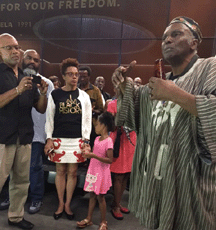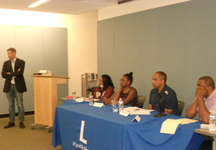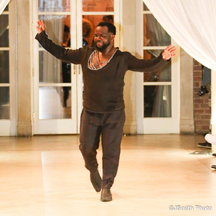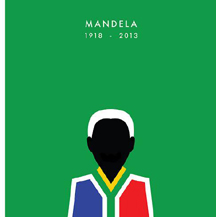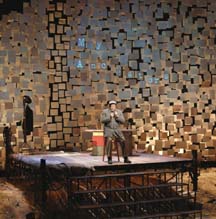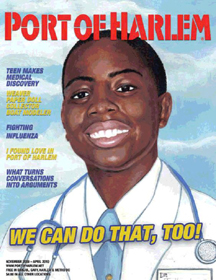Tarell Alvin McCraney, who recently received an Academy Award for Best Adapted Screenplay for “Moonlight,” returns to Studio Theater in Washington, DC. with an updated version of “Wig Out!: for Studio X.” Inspired by house (social group) ballroom culture and its competitive dance-offs, Studio's Stage 4 will become home to an underground pageant, complete with catwalk, created couture, and a cash bar. Wig Out! opens Wednesday, July 12.
“Wig Out!” marks McCraney's fifth production at Studio, making him one of Studio's most produced playwrights. Also, on July 1, McCraney assumed the position of Chair of the Yale School of Drama.
Rooted in the same cultural earth that grew “Paris is Burning” and MaDonna’s “Vogue,” Eric falls for the handsome Wilson on the subway, but he doesn’t know what he’s in for. Because Wilson is also Nina, a rising drag star in The House of Light. When a competing house calls a ball for midnight, Eric is drawn into battle. Part turf war, part pageant, all conquest.
Moonlight Creator's Play @ Studio | T Browder Tours NMAAHC | Gentrification Discussed
Having trouble viewing this email? Click here
Having trouble viewing this email? Click here
July 6 – July 19, 2017
On The Dock This Issue:

Moonlight’s McCraney’s Revived Play at Studio Theater
Tarell Alvin McCraney, who recently received an Academy Award for Best Adapted Screenplay for “Moonlight,” returns to Studio Theater in Washington, DC. Wig Out! opens Wednesday, July 12.
Tarell Alvin McCraney, who recently received an Academy Award for Best Adapted Screenplay for “Moonlight,” returns to Studio Theater in Washington, DC. Wig Out! opens Wednesday, July 12.
Tony Browder: "Use the Museum to Become the People We are to Become"
Cultural historian Tony Browder admitted that it takes about eight hours to tour the National Museum of African American History and Culture, but he hit the historical highlights in three.
Cultural historian Tony Browder admitted that it takes about eight hours to tour the National Museum of African American History and Culture, but he hit the historical highlights in three.
The Sound of DC is Changing: Thoughts on Gentrification
Developers “rebrand” neighborhoods and eliminate family-size residences as they appeal to “young White people who are afraid to death of 15-year-old Black kids with cornrows.”
Developers “rebrand” neighborhoods and eliminate family-size residences as they appeal to “young White people who are afraid to death of 15-year-old Black kids with cornrows.”
African Immigrants in the US
Compared to the total foreign-born population, sub-Saharan Africans are among the best educated says a report by The Migration Policy Institute.
Compared to the total foreign-born population, sub-Saharan Africans are among the best educated says a report by The Migration Policy Institute.
UN: Half of World's Population Growth Likely to be African
Nigeria will overtake the United States to become the third-most populous country in the world by 2050.
Nigeria will overtake the United States to become the third-most populous country in the world by 2050.
I Value Your feedback
You will get an email with a survey from Port Of Harlem magazine tomorrow, Friday, July 7, or you can take the survey by clicking the link found in the article.
You will get an email with a survey from Port Of Harlem magazine tomorrow, Friday, July 7, or you can take the survey by clicking the link found in the article.
Studio Theater promises that this will be more than just a drag show, but about the timeless desires to be desired, find your home, and dominate anyone who throws you “shade” - - whose originating subculture meaning is now used by political pundits to describe Auntie Maxine’s (Representative Maxine Water (D-CA)) “shady” attacks on 45 and Ben Carson.
“Wig Out!” marks McCraney's fifth production at Studio.
McCraney is joined by longtime artistic collaborator Kent Gash. Gash developed “Wig Out!” at the 2007 Sundance Theatre Lab and directed Studio's 2015 production of McCraney's “Choir Boy.”
“Wig Out!” marks McCraney's fifth production at Studio.
McCraney is joined by longtime artistic collaborator Kent Gash. Gash developed “Wig Out!” at the 2007 Sundance Theatre Lab and directed Studio's 2015 production of McCraney's “Choir Boy.”
Cultural historian Tony Browder admitted that it takes about eight hours to tour the National Museum of African American History and Culture, as he began a special exploration though the “shrine.” To expedite the visit, he set aside 15 minutes for touring Level 4 – Cultural Galleries, (bypassing Levels 1 through 3), with the remaining time set aside for Concourse One, Two, and Three - - The History Galleries.
Browder led the tour just hours before WOL’s PowerTalk4 conference, which featured scholars speaking about the future of the Black community and our cultural concerns. Several of the conference’s speakers including Drs. Leonard and Rosalind Jeffries, Dr. James Small, and Dr. Patricia Newton joined about 100 others on the Chicago native’s excursion of the “temple.”
“I really want you to see the Emmet Till video and "The Domestic Slave Trade" video,” Browder said to help participants best use their time. However, while viewing “The Domestic Slave Trade” video, artist George Shomari Smith thought the story was compelling but that the images were too “sanguine” compared to the life-sized three dimensional, expressive figures at the Black Wax Museum in Baltimore.
The longest lines were to see the Emmett Louis Till video and memorial that features his original casket. As Maisha Boyd moved closer to the Till memorial, she commented that she needed more than eight hours to see everything. She continued, “I need a couple of days on each floor, but the (Till) line is moving pretty fast.”
Both Smith and Boyd are Port Of Harlem subscribers. Other subscribers to also happen to be on the tour included Kafiah Williams and Kevin Pinckney, who was most fascinated by the exhibit on all Black towns such as Nicodemus, Kansas, founded in 1877.
Browder led the tour just hours before WOL’s PowerTalk4 conference, which featured scholars speaking about the future of the Black community and our cultural concerns. Several of the conference’s speakers including Drs. Leonard and Rosalind Jeffries, Dr. James Small, and Dr. Patricia Newton joined about 100 others on the Chicago native’s excursion of the “temple.”
“I really want you to see the Emmet Till video and "The Domestic Slave Trade" video,” Browder said to help participants best use their time. However, while viewing “The Domestic Slave Trade” video, artist George Shomari Smith thought the story was compelling but that the images were too “sanguine” compared to the life-sized three dimensional, expressive figures at the Black Wax Museum in Baltimore.
The longest lines were to see the Emmett Louis Till video and memorial that features his original casket. As Maisha Boyd moved closer to the Till memorial, she commented that she needed more than eight hours to see everything. She continued, “I need a couple of days on each floor, but the (Till) line is moving pretty fast.”
Both Smith and Boyd are Port Of Harlem subscribers. Other subscribers to also happen to be on the tour included Kafiah Williams and Kevin Pinckney, who was most fascinated by the exhibit on all Black towns such as Nicodemus, Kansas, founded in 1877.
The tour attracted a mostly mature audience with a sprinkling of young adults and children. “The consciousness has shifted,” acknowledged Browder’s 35-year-old daughter, Atlantis. Younger people, she says, are more interested in the “less historical” aspects of our culture.
“The struggle is not over yet,” declared Browder while in the beautiful Contemplative Court, which is near the Oprah Winfrey Theater. Sharing her father’s passion, Atlantis affirmed, “history plays an important role in all aspects of our lives.” She said that with the spirit of knowing that “your thoughts, words, and actions are a reflection of your consciousness,” the younger Browder is working on a book to help young adults and teenagers better appreciate history and develop a higher level of awareness.
With water falling from the Oculus (a circular opening in the ceiling with a view outside) and quotes by Sam Cooke, Martin Luther King, Nelson Mandela, and Francis Ellen Watkins Harper on the walls, Leonard Jeffries offered a libation to our ancestors.
The elder Browder has conducted study tours in Egypt since 1987 and developed the Egypt on the Potomac tours of Washington, DC. As an international historian, he praised architect David Adjaye (Adjaye was born in Dar es Salaam, Tanzania and is of Ghanaian descent) for building the Oculus where a slave auction block “once tore our families apart.”
Once outside the museum on the Constitution Avenue side, Rosalind Jeffries offered another libation, with female energy, and Browder pointed out how Adjaye designed the “shrine or temple” with feminine energy. The early Americans modeled the Washington Monument after the ancient African phallic symbol that represents masculine energy.
Together, he says, they represent “new birth” and that it should be our mission “not to be that what we are taught we are, but to become the people we are to become.”
“The struggle is not over yet,” declared Browder while in the beautiful Contemplative Court, which is near the Oprah Winfrey Theater. Sharing her father’s passion, Atlantis affirmed, “history plays an important role in all aspects of our lives.” She said that with the spirit of knowing that “your thoughts, words, and actions are a reflection of your consciousness,” the younger Browder is working on a book to help young adults and teenagers better appreciate history and develop a higher level of awareness.
With water falling from the Oculus (a circular opening in the ceiling with a view outside) and quotes by Sam Cooke, Martin Luther King, Nelson Mandela, and Francis Ellen Watkins Harper on the walls, Leonard Jeffries offered a libation to our ancestors.
The elder Browder has conducted study tours in Egypt since 1987 and developed the Egypt on the Potomac tours of Washington, DC. As an international historian, he praised architect David Adjaye (Adjaye was born in Dar es Salaam, Tanzania and is of Ghanaian descent) for building the Oculus where a slave auction block “once tore our families apart.”
Once outside the museum on the Constitution Avenue side, Rosalind Jeffries offered another libation, with female energy, and Browder pointed out how Adjaye designed the “shrine or temple” with feminine energy. The early Americans modeled the Washington Monument after the ancient African phallic symbol that represents masculine energy.
Together, he says, they represent “new birth” and that it should be our mission “not to be that what we are taught we are, but to become the people we are to become.”
“The sound of DC is changing,” declared Kalfani Ture, Winthrop University professor and the brainchild behind the Urban Transformation: Metropolitan Development, Demographic Change & Gentrification symposium in the heart of Washington, D.C.’s “changed” Shaw neighborhood. He added, "Where we once heard (the African-based) Go-Go music, we now hear construction “cranes.”
The northwest Washington neighborhood has been home to the largest urban population of African-Americans in the nation’s capital since the 1920s. The area was named for Colonel Robert Gould Shaw, who commanded the all-Black 54th Massachusetts Infantry during the U.S. Civil War, as depicted in the movie “Glory.”
While the greater Shaw area has become dramatically less Black, American University professor Derek Hyra believes that without subsidized housing, Shaw “would be Whiter.” Hyra, who is also author of “Race, Class, and Politics in the Cappuccino City,” explained that the DC government adds its own money to the Federal funds it gets for Section 8 housing. “Something that many other cities don’t do,” he continued.
And, while welcoming people from around the world to live in the nation’s capital and her home for 58 years, Paulette Mathews, of the Barry Farm Tenants and Allies Association, was frustrated with her struggle to remain in her southeast Washington community. “I should be able to afford to live here,” says Mathews. As for the new financially out-of-reach development coming and promised in her area, “It’s like money over people,” she says.
Ed Lazere of the DC Fiscal Policy Institute encouraged the “right to return,” to be codified. He explained how government policy led to the building of the new luxurious O Street Market in a formerly much neglected section of northwest Washington and advocates that the government equally develop policies to “ensure that the people who are already there can stay there.”
The concentration of poverty, the concentration of wealth, and uneven development fuel gentrification added George Washington University’s Gregory Squires. In 2000, 43 percent of the poor lived in high poverty neighborhoods. Today, that number has risen to 54 percent he says.
The northwest Washington neighborhood has been home to the largest urban population of African-Americans in the nation’s capital since the 1920s. The area was named for Colonel Robert Gould Shaw, who commanded the all-Black 54th Massachusetts Infantry during the U.S. Civil War, as depicted in the movie “Glory.”
While the greater Shaw area has become dramatically less Black, American University professor Derek Hyra believes that without subsidized housing, Shaw “would be Whiter.” Hyra, who is also author of “Race, Class, and Politics in the Cappuccino City,” explained that the DC government adds its own money to the Federal funds it gets for Section 8 housing. “Something that many other cities don’t do,” he continued.
And, while welcoming people from around the world to live in the nation’s capital and her home for 58 years, Paulette Mathews, of the Barry Farm Tenants and Allies Association, was frustrated with her struggle to remain in her southeast Washington community. “I should be able to afford to live here,” says Mathews. As for the new financially out-of-reach development coming and promised in her area, “It’s like money over people,” she says.
Ed Lazere of the DC Fiscal Policy Institute encouraged the “right to return,” to be codified. He explained how government policy led to the building of the new luxurious O Street Market in a formerly much neglected section of northwest Washington and advocates that the government equally develop policies to “ensure that the people who are already there can stay there.”
The concentration of poverty, the concentration of wealth, and uneven development fuel gentrification added George Washington University’s Gregory Squires. In 2000, 43 percent of the poor lived in high poverty neighborhoods. Today, that number has risen to 54 percent he says.
Former DC council member Frank Smith took a short victory lap for being a part of the DC leadership that tilled the ground for DC’s new crop of housing and other amenities. The goal, he says, was to make the city “work for everybody, including us.” Smith says he favors rent control because businesses do not have “unfettered rights to do business . . . because they won’t do the right thing.”
Echoing Smith, but questioning the motives of politicians was Parisa Norouzi of Empower DC. She talked about her group’s work in the Ivy City community were the city wanted to build a parking lot for tourist buses despite the long-term residents disapproval. Ivy City, she says, “was not attractive enough for developers and upper income White people” at that time.
From Norouzi’s perspective, it was a combination of factors that killed the parking lot proposal including litigation, a change in the local administration that may have found it politically unpopular to continue the project, and a Washington Post article that labeled Ivy City “the next hot neighborhood,” - - “which was a slap in the face of the people who have been living there for decades,” she says.
Attorney Will Merrifield of the Washington Legal Clinic was probably the most strident in his remarks about the players in gentrification. The Clinic works for the homeless who are combating developers who generally want to eliminate family size residences and replace affordable with unaffordable housing. He says of developers: “whatever they say publicly is a façade, a charade.” He added with vigor, they “rebrand” neighborhoods and eliminate family-size residences as they appeal to “young White people who are afraid to death of 15-year-old Black kids with cornrows.”
From Our Archives:
Urban Renewal, Negro Removal (Georgetown, DC History), co-narrated By Port Of Harlem contributor C.R. Gibbs
“Gentrification – Blacks Tricked?,” Publisher’s Point, By Port Of Harlem publisher Wayne A. Young
"Tangled Web: Race, Urban Renewal, and Gentrification in the Nation's Capital," By CR Gibbs was part of his 2017 - African History and Culture Lecture Series, but is currently not scheduled for the rest of this year.
Echoing Smith, but questioning the motives of politicians was Parisa Norouzi of Empower DC. She talked about her group’s work in the Ivy City community were the city wanted to build a parking lot for tourist buses despite the long-term residents disapproval. Ivy City, she says, “was not attractive enough for developers and upper income White people” at that time.
From Norouzi’s perspective, it was a combination of factors that killed the parking lot proposal including litigation, a change in the local administration that may have found it politically unpopular to continue the project, and a Washington Post article that labeled Ivy City “the next hot neighborhood,” - - “which was a slap in the face of the people who have been living there for decades,” she says.
Attorney Will Merrifield of the Washington Legal Clinic was probably the most strident in his remarks about the players in gentrification. The Clinic works for the homeless who are combating developers who generally want to eliminate family size residences and replace affordable with unaffordable housing. He says of developers: “whatever they say publicly is a façade, a charade.” He added with vigor, they “rebrand” neighborhoods and eliminate family-size residences as they appeal to “young White people who are afraid to death of 15-year-old Black kids with cornrows.”
From Our Archives:
Urban Renewal, Negro Removal (Georgetown, DC History), co-narrated By Port Of Harlem contributor C.R. Gibbs
“Gentrification – Blacks Tricked?,” Publisher’s Point, By Port Of Harlem publisher Wayne A. Young
"Tangled Web: Race, Urban Renewal, and Gentrification in the Nation's Capital," By CR Gibbs was part of his 2017 - African History and Culture Lecture Series, but is currently not scheduled for the rest of this year.
Compared to the total foreign-born population, sub-Saharan Africans are among the best educated says a report by The Migration Policy Institute. The report, Sub-Saharan African Immigrants in the United States, reveals that in 2015, 1.7 million sub-Saharan Africans lived in the United States, accounting for a small but growing share (4 percent) of the 43.3 million immigrants in the United States.
Nigerians and South Africans were the most highly educated, with 57 percent holding at least a bachelor’s degree, followed by Kenyans (44 percent), Ghanaians (40 percent), Liberians (32 percent), and Ethiopians (29 percent). Meanwhile, Somalis had the lowest educational attainment of all sub-Saharan Africans, with 11 percent having graduated from a four-year college.
The current flow of sub-Saharan Africans consists of skilled professionals, individuals seeking reunification with relatives, and refugees from war-torn countries. However, Senator Tom Cotton (R-AK) and David Purdue (R-GA) has proposed a bill that will kill the flow of Africans coming to the United States seeking to reunify with relatives. (See Black Immigration Under Attack.).
Nigerians and South Africans were the most highly educated, with 57 percent holding at least a bachelor’s degree, followed by Kenyans (44 percent), Ghanaians (40 percent), Liberians (32 percent), and Ethiopians (29 percent). Meanwhile, Somalis had the lowest educational attainment of all sub-Saharan Africans, with 11 percent having graduated from a four-year college.
The current flow of sub-Saharan Africans consists of skilled professionals, individuals seeking reunification with relatives, and refugees from war-torn countries. However, Senator Tom Cotton (R-AK) and David Purdue (R-GA) has proposed a bill that will kill the flow of Africans coming to the United States seeking to reunify with relatives. (See Black Immigration Under Attack.).
Compared to the overall immigrant population, sub-Saharan Africans were more spread out geographically. As of 2011-15, the largest shares of sub-Saharan African immigrants settled in Texas (10 percent), New York (9 percent), and Maryland (9 percent).
The top four counties by concentration of sub-Saharan Africans were Bronx County, NY; Montgomery County, MD; Harris County, TX; and Prince George’s County, MD. Together, these counties accounted for about 12 percent of the total sub-Saharan immigrant population in the United States.
Compared to the total foreign-born population, sub-Saharan Africans were much more likely to be employed in management, business, science, and arts occupations (38 percent) and much less likely to be employed in natural resources, construction, and maintenance occupations.
The top four counties by concentration of sub-Saharan Africans were Bronx County, NY; Montgomery County, MD; Harris County, TX; and Prince George’s County, MD. Together, these counties accounted for about 12 percent of the total sub-Saharan immigrant population in the United States.
Compared to the total foreign-born population, sub-Saharan Africans were much more likely to be employed in management, business, science, and arts occupations (38 percent) and much less likely to be employed in natural resources, construction, and maintenance occupations.
Nigeria will overtake the United States to become the third-most populous country in the world by 2050, according to a United Nations report.
Currently the seventh-most populous country in the world, the West African nation is projected to surpass the 300 million people mark by 2050, according to The World Population Prospects 2017.
The report predicted that the world population will hit a staggering 9.8 billion by 2050, and forecasted that over half of the expected growth between 2017 and 2050 is likely to occur in Africa.
Currently the seventh-most populous country in the world, the West African nation is projected to surpass the 300 million people mark by 2050, according to The World Population Prospects 2017.
The report predicted that the world population will hit a staggering 9.8 billion by 2050, and forecasted that over half of the expected growth between 2017 and 2050 is likely to occur in Africa.
Here are five African countries that will contribute the most to the world's population growth:
- Nigeria
- The Democratic Republic of Congo
- Ethiopia
- Tanzania
- Uganda
Click here to read briefings on each country
(Note: Demographers predict that the U.S. will be majority-minority for the first time by the mid-2040s. The country’s minority population increased from 32.9% of U.S. residents in 2004 to 37.9% in 2014 - - with four states — Hawaii, California, New Mexico, and Texas — along with Washington, D.C., now majority-minority. Nevada, which has 48.5% minority population, is likely next.)
- Nigeria
- The Democratic Republic of Congo
- Ethiopia
- Tanzania
- Uganda
Click here to read briefings on each country
(Note: Demographers predict that the U.S. will be majority-minority for the first time by the mid-2040s. The country’s minority population increased from 32.9% of U.S. residents in 2004 to 37.9% in 2014 - - with four states — Hawaii, California, New Mexico, and Texas — along with Washington, D.C., now majority-minority. Nevada, which has 48.5% minority population, is likely next.)
You will get an email with a survey from Port Of Harlem magazine tomorrow, Friday, July 7, or you can take the survey by clicking here now. It has only nine (9) short questions. Please take five (5) minutes or less to complete the survey and help us provide you a better product.
Thanks in advance, Wayne
Publisher, Port Of Harlem magazine
Thanks in advance, Wayne
Publisher, Port Of Harlem magazine
Washington
The Impact of Early Childhood
Education on Health and Well-Being
(The Latest Research from Policies for Action)
Urban Institute
2100 M Street NW, 5th floor
Wed, Jul 12, 3p-5p, free
Young Portrait Explorers: Harriet Tubman
(For toddlers up to age five and their adult companions)
National Portrait Gallery
8th Street, NW
Mon, Jul 10, 10:30a-11:30a, registration free
Baltimore
Taste of the Islands
Benjamin Banneker Park and Museum
300 Oella Road
Catonsville, MD
Sat, Jul 8, 2p-8p, $25
The Impact of Early Childhood
Education on Health and Well-Being
(The Latest Research from Policies for Action)
Urban Institute
2100 M Street NW, 5th floor
Wed, Jul 12, 3p-5p, free
Young Portrait Explorers: Harriet Tubman
(For toddlers up to age five and their adult companions)
National Portrait Gallery
8th Street, NW
Mon, Jul 10, 10:30a-11:30a, registration free
Baltimore
Taste of the Islands
Benjamin Banneker Park and Museum
300 Oella Road
Catonsville, MD
Sat, Jul 8, 2p-8p, $25
Los Angeles
Mike Tyson, booksigning
Esowon Books
4327 Degnan Blvd
Thu, Jul 13, 5p, free
New York
Chester Higgins Jr.: Passing Through
Sugar Hill Children's Museum of Art & Storytelling
898 St. Nicholas Ave.
Harlem
Thu, Jul 6-Sat, Aug 26,
Thu-Sun, 10a-5p, free-$7
World
Mandela Day
Tue, Jul 18, free
Coming
25th Annual Children Africana Book Awards
St. Francis Hall
1340 Quincy Street, NW
Friday, Nov 3, 2017, 6p- 9p, $100
Mike Tyson, booksigning
Esowon Books
4327 Degnan Blvd
Thu, Jul 13, 5p, free
New York
Chester Higgins Jr.: Passing Through
Sugar Hill Children's Museum of Art & Storytelling
898 St. Nicholas Ave.
Harlem
Thu, Jul 6-Sat, Aug 26,
Thu-Sun, 10a-5p, free-$7
World
Mandela Day
Tue, Jul 18, free
Coming
25th Annual Children Africana Book Awards
St. Francis Hall
1340 Quincy Street, NW
Friday, Nov 3, 2017, 6p- 9p, $100
On Website 
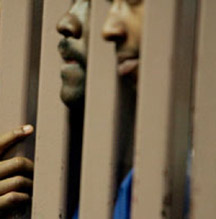
In Prison, With Dad | Lumumba Wins In Jackson | Interrace Marriages Up
June 8 – June 21, 2017 Port Of Harlem issue
(2nd consecutive)

In Prison, With Dad | Lumumba Wins In Jackson | Interrace Marriages Up
June 8 – June 21, 2017 Port Of Harlem issue
(2nd consecutive)
On Facebook 



Why haven't Cornell West and Tavis Smiley criticized the Trump administration as much as together they criticized(with vitriol) Obama?
Advertisers | Contact Us | Events | Links | Media Kit | Our Company | Payments Pier
Press Room | Print Cover Stories Archives | Electronic Issues and Talk Radio Archives | Writer's Guidelines







